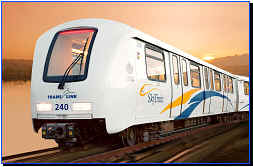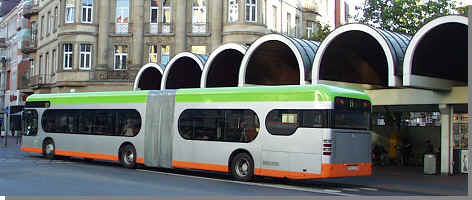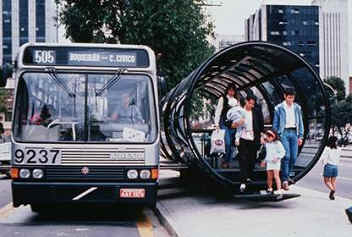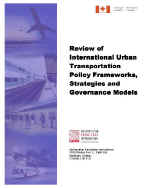|
|
 |
Lessons for Canada
Lessons
for Canada: Case Studies on Intergovernmental Cooperation in Sustainable Urban Transportation
|

This event explored how different levels of government in other countries have cooperated to implement sustainable urban transportation. Participants learned from case studies of approaches from other federal countries that could be applied within Canada to help reach our sustainability objectives.
Over three days, 80 invited representatives of Canadian governments (federal, provincial and municipal), as well as non-governmental and sector organizations, exchanged ideas with guest presenters from the United States, Germany, Switzerland, Australia, Brazil and the World Bank.
This page provides summaries of the main workshop sessions on international case studies and links to further information.
[Back to table of contents]
|
The
American Experience: Intergovernmental Approaches Under ISTEA and TEA-21
The European
Experience: Integrated Mobility
Intergovernmental
Collaboration and the Private Sector: The Australian and World Bank
Experience
The Brazilian
Experience: Leadership, Innovation and Results
Lessons Learned
Review of International Urban Transportation Policy Frameworks, Strategies and Governance Models
|
|
|
|
|
|
Brigid Hynes-Cherin (U.S. Federal Transit Administration) discussed the
U.S. federal government’s strong role in funding and influencing urban
transportation. She addressed the objectives of federal funding, sources
of funding, the variety of programs and keys to past success such as
program flexibility.
Andy Cotugno (Metro Regional Services, Portland, Oregon) discussed the
role of metropolitan planning organizations (MPOs) across the United
States, with a focus on Portland. MPOs are broad-based regional
stakeholder groups that coordinate, approve and prioritize spending of
federal funds. As Portland’s MPO, Metro has a particularly strong
history of integrated regional planning supported by political and public
consensus about the need to tackle land use and transportation challenges.
 |
Tom McCall Waterfront Park in Portland Oregon. Former location of Harbor Freeway |
Clive Rock (Director of Strategic Planning and Policy, Greater
Vancouver Transportation Authority) briefly reviewed Vancouver’s
experience in creating a regional transportation authority, and led an
open discussion. Audience questions and comments revolved around land use
and transportation coordination, MPO composition, and keys to success of
the American approach.

Skytrain in Greater Vancouver, British Columbia
[Back to table of contents]
|
View Brigid Hynes-Cherin presentation: PDF
presentation (713.27Kb) View
Andy Cotugno presentation: PDF
presentation (2.8Mb) For more information:
U.S. Federal Transit Administration
U.S Federal Highway Administration
TEA-21
The Transportation Planning
Capacity Building Program
Metro Portland
Metro’s
Regional Transportation Plan
Greater Vancouver Transportation
Authority (TransLink)
TransLink case study
|
|
|
|
Bernt Hüsken (Region of Hannover, Germany) discussed the integration of land use and transportation in Hannover, with an emphasis on residential development and public transit.

Citaro G Bus in Hanover, Germany
Peter Scheidegger (Bern, Switzerland) discussed the reasons for Switzerland’s strong transit tradition, the governance and funding structures affecting urban transportation, and the “three pillars” of transit success (supportive land use, restriction of car traffic, and transit promotion). He also addressed the competitive approach to delivery of multi-modal transit services by government-owned agencies, and the use of use of votes at all three levels (national, regional, local) to decide to decide major transportation issues.

Mutimodal connections in Switzerland
Emmanuel Le Colletter (Planning and Development, Agence métropolitaine de transport, Montreal) briefly reviewed the AMT’s role in providing integrated mobility in the Montreal region, and led an open discussion. Audience questions and comments revolved around the keys to Switzerland’s success in generating high levels of transit use and public support, and also focused on a recent proposal by the Swiss government to begin direct funding of local transportation.
[Back to table of contents]
|
View Bernt Hüsken presentation:
Section 1: Context,
Demographics, Governance and Development Plans (408.09Kb)
Section 2: Transit
Network and Heavy Rail System (502.07Kb)
Section 3: Light Rail
System (338.59Kb)
Section 4: Light Rail
Continued and Buses (590.31Kb)
View Peter Scheidegger presentation:
PDF
presentation (1.2Mb)
For more information:
Transport
in Hannover
Transport in Bremen
Swiss government
Swiss federal Office of Transport
Agence métroplitaine de
transport (Montreal)
|
|
|
Paul Amos (Transport and Urban Development, World Bank) discussed the evolving role of the private sector in transportation projects around the world, with a focus on public-private partnerships. In most circumstances, the World Bank considers transportation services to be more appropriately provided by the private sector, while it sees the issue of private involvement in transportation infrastructure as more complex.
John Stott (State Transit Authority of New South Wales, Australia) discussed Australia’s history of public-private partnerships for delivering transportation facilities and services. In Australia, a highly urbanized country, the States generally have a stronger role than local governments in shaping urban transportation. Public-private partnerships have worked well for delivering services, but have been less reliably successful in the area of infrastructure where lower-than-projected demands and high user fees have dogged some projects.

Melbourne New Model Tram
Helena Borges (Acting Director General, Surface Transportation Policy, Transport Canada) reviewed Transport Canada’s role in facilitating and fostering interest in public-private partnerships, and led an open discussion. Audience questions and comments revolved around the benefits of public-private partnerships and barriers to them, the potential for public-private partnerships to deliver congestion pricing schemes, and the integration of land use and transportation planning in Australia.
[Back to table of contents]
|
View Paul Amos presentation:
PDF presentation (198.76Kb)
View John Stott presentation:
PDF presentation
(4.0Mb)
View John Stott text:
View PDF text
(163.19Kb)
For more information:
World Bank —
Transport
World Bank — Public and Private Sector Roles in the Supply of Transport Infrastructure and Services (PDF file)
Australian Government — Transport Programmes — Public-Private Partnerships
The Canadian Council for Public-Private Partnerships
|
|
|
|
Teresa Torres (Institute of Research and Urban Planning, Curitiba) discussed the past and future of Curitiba, a city of about three million people renowned for its progressive land use planning and innovative public transportation solutions. Curitiba tightly controls development in key transit corridors, using incentives to encourage high densities and mixed uses that complement its extensive bus-based rapid transit system. Curitiba is considered an international model for sustainable development, with the highest transit ridership among Brazilian cities (over 2 million passengers daily) and the country's lowest rates of ambient pollution and per capita gas consumption, while it also enjoys rapid economic growth and high average personal incomes.

Bus stop in Curitiba, Brazil
Paul Bedford (former Chief Planner, City of Toronto) briefly reviewed opportunities and challenges related to a more sustainable Greater Toronto Area, and led an open discussion. Audience questions and comments revolved around the reasons for Curitiba’s continued success over several decades, and the sources of funding for its investment program.

Buses used in Curitiba (Section Two of Curitiba
presentation)
[Back to table of contents]
|
View
Teresa Torres presentation (PDF):
Section 1: Demographic
Information and Planning Process (589.20Kb) Section
2: Transit Network and Bus Types (402.64Kb) Section
3: Public Transit (Structural Corridors, Integration, Network Map,
Pedestrians and Buses) (626.37Kb) Section
4: Heritage Preservation and Environmental Protection, Social Housing and
Job Opportunities (571.68Kb) Section
5: Metropolitan Scenario, New Development, Intergovernmental Relations and
Budgets (615.43Kb)
For more information:
Institute of Research and Urban Planning,
Curitiba City of
Curitiba (Portugese)
Curitiba case
study
Official Plan, City of Toronto
|
|
|
A panel discussion among representatives from the federal, provincial, regional, municipal, academic and non-governmental sectors highlighted a number of lessons learned from the international case study presentations:
- Transportation is vital to urban quality of life, but the real issues extend beyond transportation to reflect the role of urban areas as Canada’s centres of economy and culture
- Urban areas need predictable, long-term funding to make transportation more sustainable
- Senior government funders have a right to influence local planning, but should be descriptive (i.e. focus on outcomes) rather than prescriptive (i.e. focus on process)
- Flexibility (both provincial and regional) is essential, as is respect for provincial jurisdiction
- Funding should go to projects that are most needed, not just those that are ready for construction
- Having a single regional authority is a great benefit, although its composition and mandate may vary among
regions
- Planning needs to be more integrated (e.g. land use with transportation, local with regional, short-term with long-term)
- Potential partnerships exist with business, non-governmental, transportation and academic sectors
- Political courage at the municipal level is required to make hard choices in pursuit of long-term sustainability, and communities receiving senior government funding should be required to follow through
- A transparent federal funding policy regarding public-private partnership projects is required
- There is a valuable federal role in helping urban areas forecast and monitor development, transportation behaviours and their impacts (e.g. on public health)
- Federal support should extend beyond infrastructure funding to include tax relief, research and development
[Back to table of contents]
|
|
|
|
Michael Lehman (Metropolitan Knowledge International) presented the results of a recent study commissioned by Transport Canada. The project examined how other nations are addressing urban transportation challenges, and focused on governance trends affecting urban transportation, policies and programs that federal governments use to influence urban transportation, and approaches to funding urban transportation. The six nations studied were Australia, France, Switzerland, the United Kingdom, New Zealand and the United States. 
Light Rail Transit Vehicle
Audience questions and discussion revolved around finding a desirable balance among federal, provincial and local powers, the influence of climate change as a policy driver, and national differences in discretionary versus formula funding.
[Back to table of contents]
|
View Michael Lehman presentation:
PDF presentation (1.1Mb)
For more information:

PDF report (1.3Mb)
|
|
|
Transport Canada would like to thank the Forum of Federations for their
assistance in organizing this event. Thank you to the presenters and
discussants for taking the time to share their expertise.
Images and presentations on this page are courtesy of workshop
presenters.
[Back to table of contents]
|
|
|
|
The study report is available in PDF format and may be viewed using
version 3.0 or higher of the Adobe® Acrobat Reader. This reader may
be downloaded free of charge by visiting the Adobe®
web site. The study
report
(file size 1.3Mb) will download in approximately 406 seconds on a 28.8K connection.
[Back to table of contents]
|
|
|
|
These presentations are available in PDF format and may be viewed using
version 3.0 or higher of the Adobe® Acrobat Reader. This reader may
be downloaded free of charge by visiting the Adobe®
web site. The Brigid Hynes-Cherin presentation
(file size 713.27Kb) and Andy Cotugno presentation
(file size 2.8Mb) will download in approximately 222 and 875
seconds on a 28.8K connection.
[Back to table of contents]
|
|
|
|
These presentations are available in PDF format and may be viewed using
version 3.0 or higher of the Adobe® Acrobat Reader. This reader may
be downloaded free of charge by visiting the Adobe®
web site. The
Bernt Hüsken presentation, which is divided into section
1 (file size 408.09Kb), section
2 (file size 502.07Kb), section
3 (file size 338.59Kb), and section
4 (file size 590.31Kb), will download in approximately 127,
156, 105 and 184 seconds on a 28.8K connection. The Scheidegger presentation
(file size 1.2Mb) will download in approximately 375 seconds
on a 28.8K connection.
[Back to table of contents]
|
|
|
|
These presentations are available in PDF format and may be viewed using
version 3.0 or higher of the Adobe® Acrobat Reader. This reader may
be downloaded free of charge by visiting the Adobe®
web site. The
Paul Amos presentation
(file size 198.76Kb) and John Stott presentation
(file size 4.0Mb) and text
(file size 163.19Kb) will download in approximately 62, 1250 and
50 seconds on a 28.8K connection.
[Back to table of contents]
|
|
|
|
These presentations are available in PDF format and may be viewed using
version 3.0 or higher of the Adobe® Acrobat Reader. This reader may
be downloaded free of charge by visiting the Adobe®
web site. The Teresa Torres presentation, which is divided into section
1 (file size 589.20Kb), section
2 (file size 402.64Kb), section
3 (file size 626.37Kb), section
4 (file size 571.68Kb), and section
5 (file size 615.43Kb), will download in approximately 184,
125, 195, 178 and 192 seconds on a 28.8K connection.
[Back to table of contents]
|
|
|
|
This presentation is available in PDF format and may be viewed using
version 3.0 or higher of the Adobe® Acrobat Reader. This reader may
be downloaded free of charge by visiting the Adobe®
web site. The
Michael Lehman presentation (file size 1.1Mb) will download in
approximately 343 seconds on a 28.8K connection.
[Back to table of contents]
|
|
|
|
Transport Canada assumes no responsibility for the accuracy, currency or reliability of the content of sites external to Transport Canada. Links to external sites do not imply Transport Canada's official approval of the content of the sites or the organizations hosting them.
[Back to table of contents]
|
|

